The Paper and Paperboard Packaging Environmental Council (PPEC) monitors environmental issues impacting the Canadian paper packaging industry, especially recycling, since recycled paper-based materials are an important supply of our industry’s feedstock.
To that end, we track federal and provincial government activities on Extended Producer Responsibility (EPR), which is a policy approach in which a producer is made financially and physically responsible for ensuring their packaging is properly managed at the end of its life.
In Canada, EPR policies have been mostly applied to managing waste and recyclables in the residential sector – that’s you and I at home – while paper and packaging from the Industrial, Commercial, and Institutional (IC&I) sector is managed separately.
But lately, some provincial governments have been considering EPR approaches for managing paper and packaging materials from the IC&I sector, similar to the approach used for managing materials from residential sources, leaving PPEC to wonder if we are putting the cart before the horse when it comes to EPR and the IC&I sector.
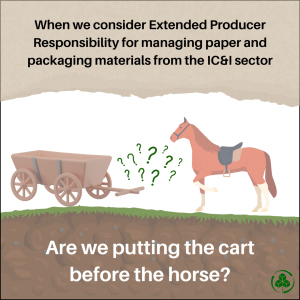
Current State of EPR
Historically, paper and packaging recycling for residential communities has been provided by municipalities as part of their waste management services. And over the last few decades, several provincial governments passed legislation that legally require businesses who make and sell packaging to submit data reports and fund municipal recycling costs. These are known as “cost-shared” program models, wherein municipalities run the programs and businesses pay a portion of the costs.
However, over the past few years, there has been a shift to move towards EPR-based models, where businesses would be responsible for 100% of program operations and funding. If municipalities want to continue their role as a service provider, they would need to agree to terms set by industry; otherwise, industry will negotiate with waste collectors, haulers, and processing facilities directly.
This EPR model currently only truly exists in British Columbia but is being rolled out in other provinces within the next few years.
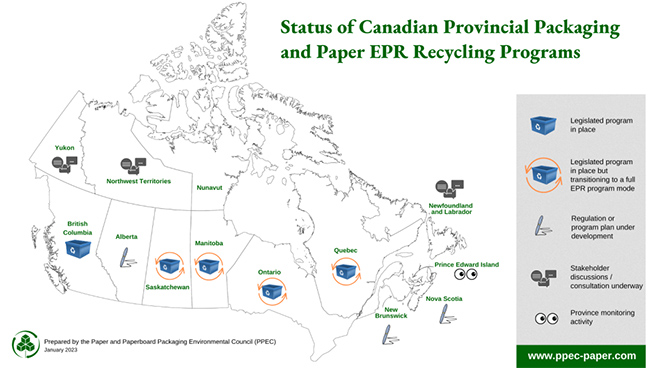 The above map shows the status of provincial recycling programs for managing residential paper and packaging, but what about paper and packaging from the IC&I sector…
The above map shows the status of provincial recycling programs for managing residential paper and packaging, but what about paper and packaging from the IC&I sector…
Paper and Packaging in the IC&I Sector
In the IC&I sector – which includes office buildings, schools, hospitals, retailers, grocers, malls, stadiums, theatres, restaurants, and manufacturing facilities – businesses are responsible for managing their own waste and recyclables. This is typically done through business-to-business relationships, where businesses contract directly with waste management service providers.
But over the last few years, some provincial governments have been discussing the possibility of an EPR approach for the IC&I sector.
In fact, Québec became the first precedent-setting province to regulate EPR for managing IC&I materials. It came as part of their move to modernize the existing recycling system for packaging, with the full rollout of the new EPR system for curbside residential and IC&I expected to be completed by January 1, 2025.
British Columbia’s EPR Five-Year Action Plan states that the government is evaluating opportunities and policy options related to improving the recovery and recycling of packaging and paper in the IC&I sector. That does not necessarily mean British Columbia will implement an EPR approach for IC&I, but it does appear to be something they are potentially considering.
And lately, other provinces that have been consulting on establishing new EPR approaches for residential waste streams have also been considering whether to include some IC&I sources of waste in future EPR programs.
PPEC’s Perspective
While PPEC supports increased diversion and recycling of paper packaging materials from all sectors, IC&I included, we believe that EPR is not necessarily the right overarching policy approach for managing these materials, especially since they are currently being collected and recycled in many jurisdictions across Canada.
First, we can’t assume the same approach used for residential will work for the IC&I sector, as they are two very different and distinct waste streams.
Second, we question if EPR, as it is currently structured and understood, is working as effectively and efficiently as it could be for Canada’s residential Blue Box programs. It may be premature to suggest that the model is right and should be considered for other sectors. The reality is only one province, British Columbia, currently has a true EPR model; while other provinces are in the midst of transitioning programs to EPR or are just starting to develop new programs. It will take time to see if these shifts to EPR result in improved consumer participation, less contamination, better program performance, and overall higher recycling rates.
And third, producers are already taking responsibility for managing their waste and recyclables in the IC&I sector. We know materials are being recycled in the sector as we see it happening firsthand in our industry every single day. Most PPEC member mills use recycled paper packaging materials, including cardboard – collected from commercial and residential sources – as their primary feedstock, allowing them to use high amounts of recycled content in the major paper packaging grades made in Canada. In many cases, PPEC members have their own recycling divisions to make sure they have a good supply of recycled paper fibres that they rely on. Using recycled content is an inherent part of the Canadian paper packaging industry’s operations, and it has been that way for decades.
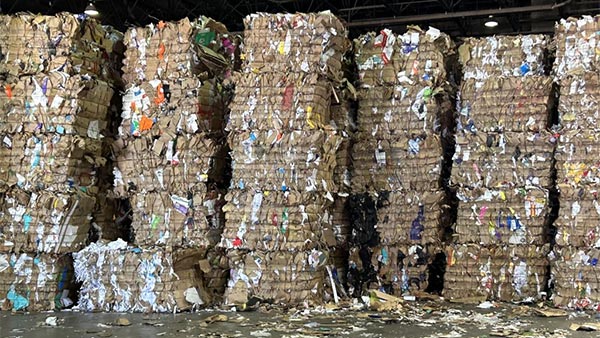 Bales of Old Corrugated Containers (OCC), collected from commercial sources and processed at the Cascades Recovery+ facility in Scarborough, Ontario, are ready to be sent to a mill, where they will be recycled so they can be remade into new paper-based packaging. Photo taken by PPEC on April 14, 2023.
Bales of Old Corrugated Containers (OCC), collected from commercial sources and processed at the Cascades Recovery+ facility in Scarborough, Ontario, are ready to be sent to a mill, where they will be recycled so they can be remade into new paper-based packaging. Photo taken by PPEC on April 14, 2023.
The Need for Data
It is important that any policy considerations or future decisions be based on sound data. As we stated earlier, paper and packaging in the IC&I sector is already being collected and recycled as businesses contract directly with waste management service providers to collect and recycle their packaging and shipping materials.
PPEC reviewed the latest available data from Statistics Canada’s Biennial Waste Management Survey, which tracks waste diversion from the IC&I sector, and it shows that paper fibres lead the way when it comes to diverted materials from non-residential sources (which includes both the IC&I and the Construction, Renovation and Demolition sectors), with 1,954,655 tonnes of paper fibres diverted in Canada in 2020, representing 46% of total diverted materials (4,214,742 tonnes based on available information) from non-residential sources.

And when it comes to provincial performance, the data shows that several provinces divert more paper fibres from non-residential sources (orange line) than from residential sources (blue line).
We recognize that this data is not perfect, but the trend is encouraging, showing that paper fibres from non-residential sources are being actively recycled and diverted from landfill in Canada.
But we know that not all paper fibres are being diverted.
According to the Government of Canada’s National Waste Characterization Report, the main waste categories in the IC&I sector in 2016 were food and non-degradables at over 60%, while the category of paper represents 14% (though no information is available to describe the composition of the paper waste).
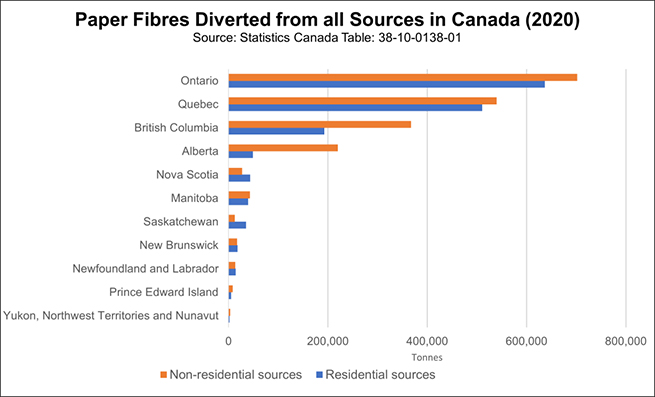
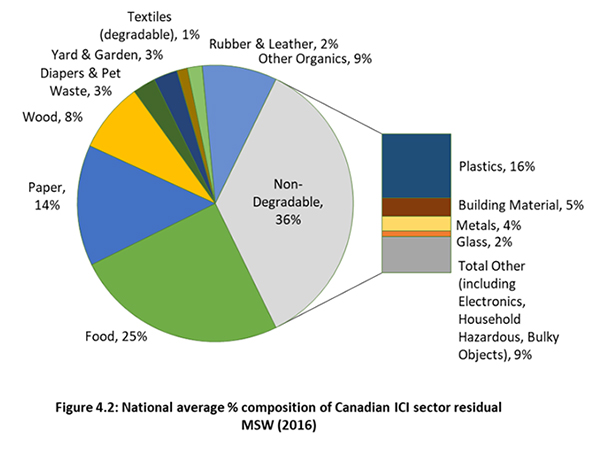 Average national characterization of waste from the ICI sector in Canada in 2016
Average national characterization of waste from the ICI sector in Canada in 2016
(Source: National Waste Characterization Report)
The data is piecemeal at best. To gain a better understanding of current IC&I waste diversion activity, better data is needed to inform policy discussions.
Key Takeaways and Next Steps
To develop effective strategies and policies for IC&I waste diversion, data is needed. We need to know the statistics about waste in the IC&I sector – how much is being generated, recycled, and disposed of, as well as the composition and types of materials – to be able to identify opportunities to increase recycling.
The existing data is not complete, but it does broadly illustrate what PPEC believes to be true for the Canadian paper packaging industry: that the major paper packaging grades, such as containerboard (used to make cardboard boxes) and boxboard (used to make cereal or shoe boxes), are being collected from the backs of supermarkets, malls, and factories, and being responsibly recycled and diverted from landfill. We know this because using recycled content is an inherent part of our members’ operations.
And when it comes to EPR and IC&I, our message to governments is clear: do not put the cart before the horse.
Let’s not assume that the same approach for residential recycling will work for the IC&I sector since they are two different waste streams. And let’s not assume we have the right formula for EPR.
In many ways, EPR for residential paper and packaging is in its infancy in Canada, with only British Columbia currently having an EPR approach, while other provinces are transitioning to producer responsibility models. It will take time to see if these shifts result in higher recycling rates and more efficient and effective systems.
Let’s get EPR for residential right first before we even consider applying it elsewhere. Getting it right means that consumers understand their important role in properly recycling. Getting it right means focusing beyond just collection, and recycling more of what is being collected. Getting it right means having end markets consistently available to ensure materials are being recycled.
In the meantime, PPEC will be watching Québec closely as the precedent-setting province that regulated an EPR approach for managing materials in the IC&I sector; and we will continue to encourage governments to collect updated data to have informed policy discussions; while we keep promoting our industry’s circular economy approach to managing paper-based packaging materials in Canada.
 Rachel Kagan
Rachel Kagan
Executive Director
The Paper & Paperboard Packaging Environmental Council (PPEC)













